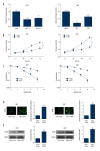Downregulation of lncRNA X Inactive Specific Transcript (XIST) Suppresses Cell Proliferation and Enhances Radiosensitivity by Upregulating mir-29c in Nasopharyngeal Carcinoma Cells
- PMID: 28985197
- PMCID: PMC5642646
- DOI: 10.12659/msm.905370
Downregulation of lncRNA X Inactive Specific Transcript (XIST) Suppresses Cell Proliferation and Enhances Radiosensitivity by Upregulating mir-29c in Nasopharyngeal Carcinoma Cells
Abstract
BACKGROUND LncRNA X inactive specific transcript (XIST) was reported to function as an oncogene in nasopharyngeal carcinoma cells (NPC) by sponging miR-34a-5p. However, the role of XIST in modulating the radiosensitivity of NPC cells and its mechanism still remain undefined. MATERIAL AND METHODS The expressions of XIST and miR-29c in NPC cells were evaluated by qRT-PCR. CNE1 and CNE2 cells were transfected with si-XIST, pcDNA-XIST, miR-29c mimics, anti-miR-29c, or respective controls by Lipofectamine 2000. The effects of XIST knockdown and miR-29c overexpression on cell proliferation, survival fraction, and γ-H2AX expression were investigated by CCK-8 assay, colony formation assay, immunofluorescence, and Western blot, respectively. Luciferase reporter assay and qRT-PCR analysis were performed to confirm whether XIST interacts with miR-29c and regulates its expression. RESULTS XIST was upregulated and miR-29c was downregulated in NPC cells. The expressions of XIST and miR-29c changed reversely in response to irradiation. Knockdown of XIST and miR-29c overexpression both resulted in a dramatic suppression of cell proliferation, a marked enhancement of radiosensitivity, and an obvious increase of γ-H2AX foci formation in NPC cells. Luciferase reporter assay and qRT-PCR analysis demonstrated that XIST interacts with miR-29c and negatively regulates its expression. Moreover, miR-29c inhibition abrogated XIST knockdown-induced cell proliferation inhibition and radiosensitivity increase in NPC cells. CONCLUSIONS XIST knockdown suppressed cell proliferation and enhanced radiosensitivity of NPC cells by upregulating miR-29c, providing a novel therapeutic target to improve radiotherapy efficiency for patients with NPC.
Conflict of interest statement
None.
Figures





Similar articles
-
Downregulation of lncRNA ANRIL inhibits proliferation, induces apoptosis, and enhances radiosensitivity in nasopharyngeal carcinoma cells through regulating miR-125a.Cancer Biol Ther. 2017 May 4;18(5):331-338. doi: 10.1080/15384047.2017.1310348. Epub 2017 Apr 12. Cancer Biol Ther. 2017. PMID: 28402230 Free PMC article.
-
LncRNA XIST knockdown suppresses the malignancy of human nasopharyngeal carcinoma through XIST/miRNA-148a-3p/ADAM17 pathway in vitro and in vivo.Biomed Pharmacother. 2020 Jan;121:109620. doi: 10.1016/j.biopha.2019.109620. Epub 2019 Nov 20. Biomed Pharmacother. 2020. PMID: 31810117
-
Knockdown of lncRNA XIST inhibits hypoxia-induced glycolysis, migration and invasion through regulating miR-381-3p/NEK5 axis in nasopharyngeal carcinoma.Eur Rev Med Pharmacol Sci. 2020 Mar;24(5):2505-2517. doi: 10.26355/eurrev_202003_20518. Eur Rev Med Pharmacol Sci. 2020. PMID: 32196601
-
Emerging roles of lncRNA in Nasopharyngeal Carcinoma and therapeutic opportunities.Int J Biol Sci. 2022 Mar 28;18(7):2714-2728. doi: 10.7150/ijbs.70292. eCollection 2022. Int J Biol Sci. 2022. PMID: 35541920 Free PMC article. Review.
-
Biomarkers for use in monitoring responses of nasopharyngeal carcinoma cells to ionizing radiation.Sensors (Basel). 2012;12(7):8832-46. doi: 10.3390/s120708832. Epub 2012 Jun 27. Sensors (Basel). 2012. PMID: 23012520 Free PMC article. Review.
Cited by
-
Precision medicine in nasopharyngeal carcinoma: comprehensive review of past, present, and future prospect.J Transl Med. 2023 Nov 6;21(1):786. doi: 10.1186/s12967-023-04673-8. J Transl Med. 2023. PMID: 37932756 Free PMC article. Review.
-
lncRNA XIST regulates cell proliferation, migration and invasion via regulating miR-30b and RECK in nasopharyngeal carcinoma.Oncol Lett. 2021 Apr;21(4):256. doi: 10.3892/ol.2021.12513. Epub 2021 Feb 4. Oncol Lett. 2021. PMID: 33664820 Free PMC article.
-
Long Noncoding RNA X-Inactive Specific Transcript (XIST) Promotes Osteogenic Differentiation of Periodontal Ligament Stem Cells by Sponging MicroRNA-214-3p.Med Sci Monit. 2020 Feb 14;26:e918932. doi: 10.12659/MSM.918932. Med Sci Monit. 2020. PMID: 32057034 Free PMC article.
-
Knockdown of lncRNA X inactive specific transcript (XIST) radiosensitizes non-small cell lung cancer (NSCLC) cells through regulation of miR-16-5p/WEE1 G2 checkpoint kinase (WEE1) axis.Int J Immunopathol Pharmacol. 2021 Jan-Dec;35:2058738420966087. doi: 10.1177/2058738420966087. Int J Immunopathol Pharmacol. 2021. PMID: 33583218 Free PMC article.
-
Involvement of Non-Coding RNAs in Chemo- and Radioresistance of Nasopharyngeal Carcinoma.Cancer Manag Res. 2021 Nov 23;13:8781-8794. doi: 10.2147/CMAR.S336265. eCollection 2021. Cancer Manag Res. 2021. PMID: 34849030 Free PMC article. Review.
References
-
- Wei WI, Sham JS. Nasopharyngeal carcinoma. Lancet. 2005;365(9476):2041–54. - PubMed
-
- Loong HH, Ma BB, Chan AT. Update on the management and therapeutic monitoring of advanced nasopharyngeal cancer. Hematol Oncol Clin North Am. 2008;22(6):1267–78. - PubMed
-
- Chua ML, Wee JT, Hui EP, Chan AT. Nasopharyngeal carcinoma. Lancet. 2016;387(10022):1012–24. - PubMed
MeSH terms
Substances
LinkOut - more resources
Full Text Sources

